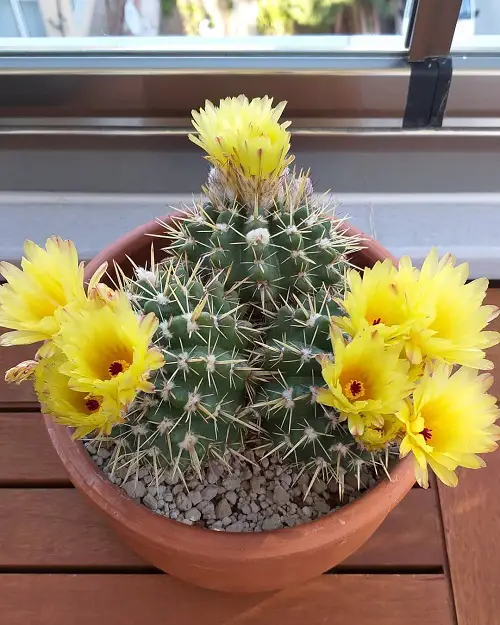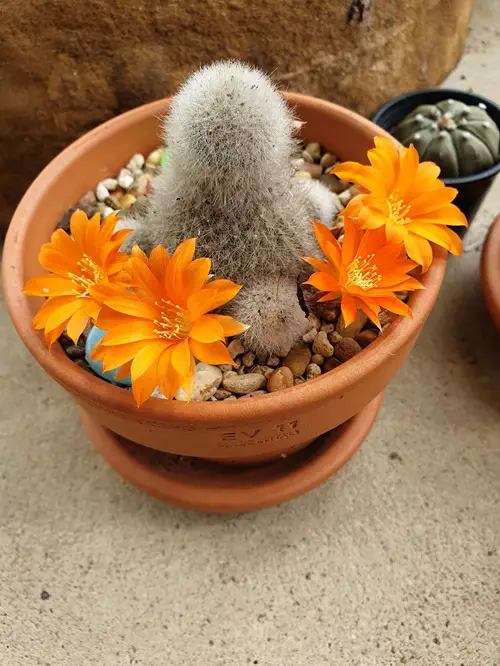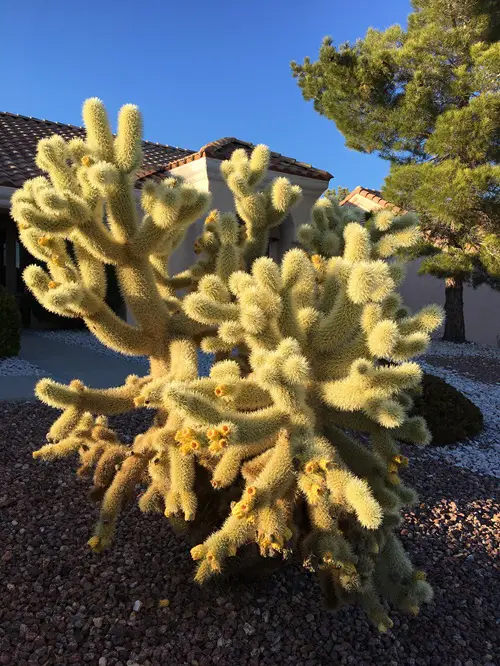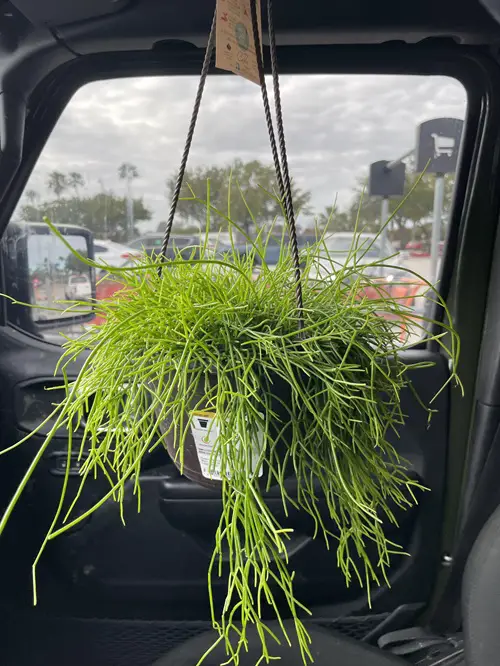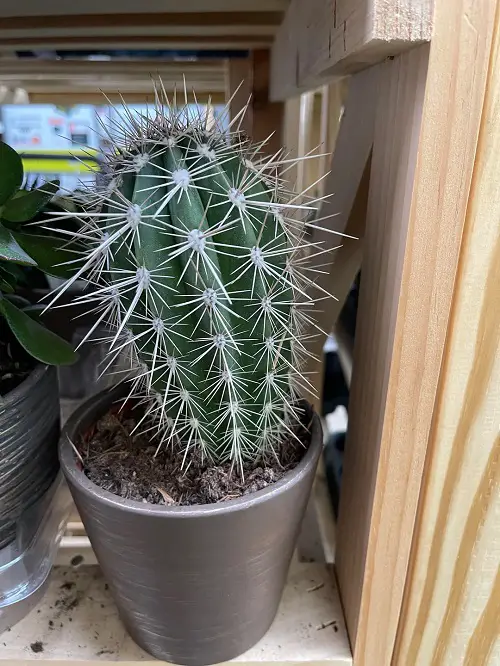If you are also falling in love with cacti then this post is just for you! Check out the best cactus varieties that are uniquely gorgeous.
Did you know the cactus family boasts over 1,700 varieties? That’s a whole lot of spiky love to go around! These flowering plants are prickly and flourish in dry conditions. Cacti are also sought after as ornamental plants because they bloom every year. So, check out the top varieties of cactus houseplants in detail.
Best Cactus Varieties
1. Old Lady Cactus
Botanical name: Mammillaria hahniana
USDA Zones: 11-13
The old lady cactus can grow up to 10 inches in height and widen up to 20 inches. This native plant of central Mexico blooms in the spring and summer with spherical, reddish-purple flowers on its stems like a crown on the head. Refrain from watering it during winter, and water intermittently during its growing phase in summer.
2. Tom Thumb Cactus
Botanical name: Parodia mammulosa
USDA Zones: 9b-11b
Tom Thumb cactus is a small perennial succulent that grows spherical. It likes rocky soil, low-land areas, and mountainous regions. This plant produces bright yellow flowers between late spring and early summer. Its blooms are funnel-shaped and are just the icing on the cake.
3. Monkey Tail Cactus
Botanical name: Cleistocactus colademononis
USDA Zones: 9-11
The monkey tail cactus resembles monkeys peeking out of a basket! This is a long cascading plant from the mountains of Bolivia. It is an epiphyte in its natural habitat and doesn’t need any soil to grow.
This cactus is covered with soft, white spines, hence an excellent decorative plant. Also, it doesn’t need much watering and thrives in a well-drained medium.
4. Red Torch Cactus
Botanical name: Echinopsis huasca
USDA Zones: 9-11
Red torch cactus is a hardy plant valued because of its ornamental nature. It produces bright red flowers during spring and summer. This beauty can be propagated either by division or grafting. Prefers an airy medium, and regular pruning will help it stay healthier.
5. Blue Myrtle Cactus
Botanical name: Myrtillocactus geometrizans
USDA Zones: 9-11
This cactus species originates from central and northern Mexico and can reach up to 5 meters in its natural environment. However, it can be trained to stay compact while growing indoors. Blue myrtle cactus produces white flowers and purple berries that look like bilberry and whortleberry fruit.
6. Rainbow Hedgehog
Botanical name: Echinocereus rigidissimus
USDA Zones: 8-11
A rainbow hedgehog is a medium-sized cactus that grows on sloppy hills and slanted areas. This cactus is remarkable because of its vibrant spines and huge yellow or magenta color flowers. It doesn’t need frequent watering and grows well in airy, well-drained soil.
7. Miniature Saguaro
Botanical name: Euphorbia aeruginosa
USDA Zones: 10-11
Straight from South Africa and Zimbabwe, the miniature saguaro is similar to the classic saguaro, one of the best cactus varieties in Arizona. However, this baby stays small, and easily manageable throughout its lifecycle. You can grow it in containers or decorate succulent gardens and rockeries.
8. Thanksgiving Cactus
Botanical name: Sclumbergera truncata
USDA Zones: 10-11
This epiphytic cactus usually flowers near Thanksgiving day, and that is why it is called “Thanksgiving cactus.” Unlike other cacti, this one likes highly humid environments and struggles in hot climates. It can grow up to 1 foot tall and produces red and magenta flowers from November to March.
9. Golden Barrel Cactus
Botanical name: Echinocactus grusonii
USDA Zones: 9 to 11
This fast-growing cactus reaches 3 feet and prefers airy soil with proper drainage. Like all cacti, you don’t need to water it frequently after its establishment. Golden barrel cactus thrives in full sun conditions and produces bright yellow flowers in summer.
10. Feather Cactus
Botanical name: Mammillaria plumosa
USDA Zones: 9-10
Feather cactus is a northwestern Mexico native that can be best grown inside containers. This plant is not cold-hardy and should be provided with some protection in winter. Its body is covered with soft white spines that impart a rounded shape.
This cactus will need regular watering in the summer, and you can propagate it through cuttings, offsets, and seeds.
11. Moon Cactus
Botanical name: Gymnocalycium mihanovichii
USDA Zones: 11-12
Moon cactus, or the Ruby Ball, is a small-sized cactus hybrid that has a grafted cactus atop a green base. Sunlight can burn its beautiful top, and hence, the best practice would be to keep it in bright but indirect light. Water it every 3 to 4 weeks, and only when the topmost soil layer feels dry.
12. Peanut Cactus
Botanical name: Echinopsis chamaecereus
USDA Zones: 10-11
Peanut cactus is a branched cactus with crowded peanut-like stems and a trailing growth habit. It is a soft and easier-to-handle cactus, that also makes it a popular houseplant. This plant performs well in bright and sunny light, but should be protected against the afternoon sun in some regions.
13. Little Mouse Cactus
Botanical name: Rebutia muscula
USDA Zones: 10-11
Little mouse cactus is local to Bolivia’s rocky areas and therefore adapts well to dry and harsh climates. This perennial grows in clusters and forms extensive mounds over time. It also produces beautiful orange or red flowers which increase its ornamental value.
14. Twin-Spined Cactus

Botanical name: Mammillaria geminispina
USDA Zones: 9-11
Twin-spined cactus grows slowly and can get as tall as 5 feet in northern Mexico. This clumpy cactus has 2 central spines and about 15 to 20 interlaced radials. It likes full sun and produces pink and magenta flowers throughout summer and autumn.
15. Easter Lily Cactus

Botanical name: Echinopsis oxygona
USDA Zones: 8-11
The eastern lily cactus is a Brazilian native and has a peculiar mat-forming habit. This fast-growing cactus can tolerate full sun and partial shades, but it may need a little more watering than other cactuses. You can use its offsets to propagate new plants, and likewise, propagation is also possible through seeds.
16. Teddy Bear Cholla Cactus
Botanical name: Cylindropuntia bigelovii
USDA Zones: 9a-11b
Teddy bear cholla grows up to 5 feet in its local region of Mexico, Arizona, and Nevada. It looks cuddly because of the dense spines that veil the stem completely. The base of this cactus is black with new branches appearing in golden and silver tones.
17. Bunny Ears Cactus

Botanical name: Opuntia microdasys
USDA Zones: 9-11
The Bunny Ear Cactus is an amazing houseplant. It is also called rabbit ears or bunny cactus because of its thick, green, pad-like leaves. In place of spines, they have brown orchids that can be easily separated from the pads. This plant also produces bowl-shaped creamy flowers during spring and summer.
18. Rat tail Cactus
Botanical name: Aporocactus flagelliformis
USDA Zones: 10-11
Its stems look like a rat’s tail and is a popular houseplant due to its low maintenance. Rat tail is actually from Mexico where it thrives in indirect light and properly-drained soil. While growing at home, feed it with a diluted fertilizer during the growing season, and repot it once a year
19. Prickly Pear Cactus

Botanical name: Opuntia spp.
USDA Zones: 9-11
Prickly pears grow near washes, rocky hillsides, and even around boulders. These plants can live up to 20 years and can be easily identified, thanks to their flat, green pads. There are white spines over the pads and produce reddish-pink flowers in spring.
20. Bishop’s Cap Cactus

Botanical name: Astrophytum myriostigma
USDA Zones: 9-11
This cactus variety looks like a green star and tends to remain compact throughout its lifecycle. It is a slow grower that rejoices in temperatures between 15 and 30 degrees Celsius. Bishop’s cap also produces large creamish-white flowers on its cylindrical stems.
21. Scarlet Ball Cactus
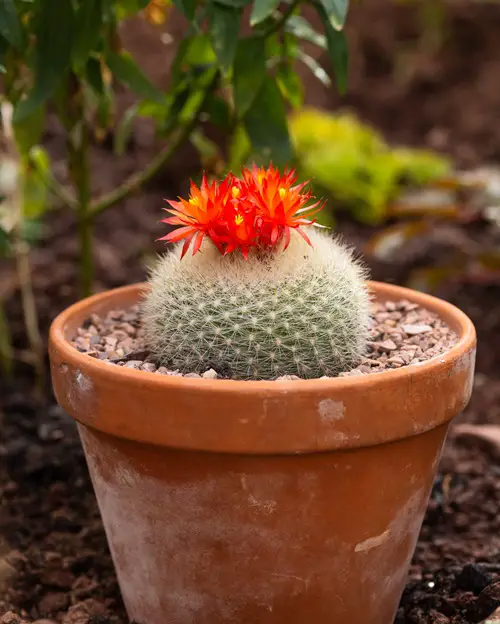
Botanical name: Parodia haselbergii
USDA Zones: 9-12
The scarlet ball cactus is a small cactus that is completely covered by around 10 cm long white spines. You can water it once every 14 days but let the soil dry out completely before watering again. It is suitable for growers of all skill levels, as it doesn’t need much care or fertilizers.
22. Mistletoe Cactus
Botanical name: Rhipsalis baccifera
USDA Zones: 9-11
The coral cactus is epiphytic and lithophytic in its local region of Central and South America. It likes frequent watering throughout spring and summer, and cannot tolerate direct sunlight for long periods. During the flowering season, provide it with a tomato-type fertilizer every two weeks, and cut down the frequency to a monthly supply for the rest of the year.
Plus. it is a spineless cactus that has no leaves and produces small white-petaled flowers. Mistletoe Cactus also produces rounded white fruits that appear directly from its branches.
23. Ric-Rac Cactus

Botanical name: Epiphyllum anguliger
USDA Zones: 10-11
Direct sunlight can cause Ric-rac’s leaves to turn yellow as it performs best in indirect and bright light. In its native region of Mexico, it grows over plants as an epiphyte. As ric-rac is from tropical rainforests, it prefers warm and humid environments and can be best placed in bathrooms and kitchens
24. Ladyfinger Cactus
Botanical name: Mammillaria elongata
USDA Zones: 9-11
Ladyfinger cactus can be grown easily as it tolerates full sun and partially shaded conditions. This plant is local to Mexico, where it was cultivated for ornamental purposes. It blooms in summer to produce yellow, white, and pink flowers.
For best growth, fertilize it with a cactus-specific diluted fertilizer every 4 to 6 weeks in spring and summer.
25. Cathedral Cactus
Botanical name: Euphorbia trigona
USDA Zones: 9-11
The Cathedral cactus is a succulent shrub with upright stems and a vertical growth pattern. This species can withstand moderately cool temperatures and performs well in sandy, well-drained soil. Its latex is poisonous and can cause itching when in contact with the skin.
This popular houseplant may also need support upon maturity as it tends to fall over because of its small root system.
26. Fishhook Barrel Cactus
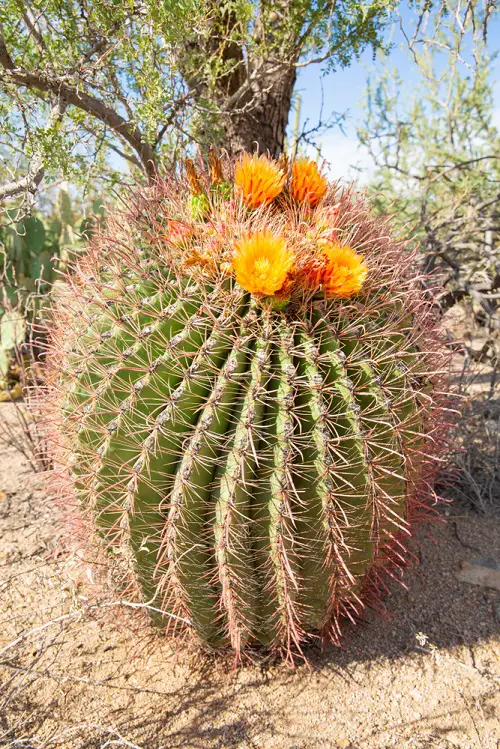
Botanical name: Ferocactus wislizeni
USDA Zones: 9-10
The Fishhook Barrel Cactus is one that is popular for its robust, cylindrical shape and distinctive spines that curve like fishhooks. Local to the southwestern United States and northern Mexico, this cactus is built to handle tough, arid conditions like a pro.
During late summer and fall, it produces beautiful yellow or orange flowers that eventually give way to small, edible fruit. Perfect for xeriscapes or rock gardens, this cactus doesn’t ask for much in return.
27. Fairy Castle Cactus
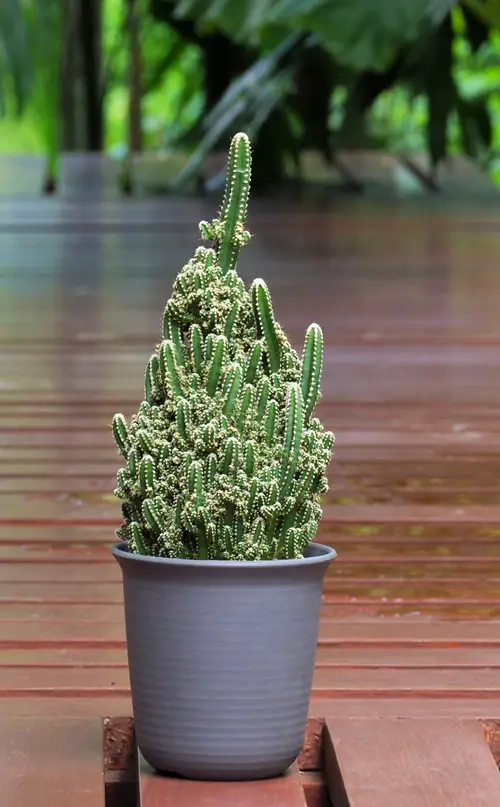
Botanical name: Acanthocereus tetragonus
USDA Zones: 10-11
This Floridan columnar cactus grows between 6 to 25 feet with dark green angular stems. It usually grows in dry dry coastal habitats and produces gorgeous white flowers with a deep red center. And also famous as a night-blooming cactus as the flowers blossom during the night and close during the day.
28. Thimble Cactus

Botanical name: Mammillaria vetula
USDA Zones: 9-11
Thimble cactus has cylindrical and columnar stems that can stretch up to 6 inches. This cactus produces creamy and white flowers in late summer and is a great choice for containers and rock gardens. Additionally, It also loves full sun and well-drained acidic soil, and is resistant to pests and diseases.
29. Saguaro Cactus
Botanical name: Carnegiea gigantea
USDA Zones: 8-11
Saguaro is a popular Arizonian variety and the largest cactus in the United States. It is commonly found in the Sonoran desert and it can grow up to 50 feet tall. In addition, this cactus can live up to 200 years and is a symbol of the American Southwest culture.
30. Sand Dollar Cactus

Botanical name: Astrophytum asteria
USDA Zones: 9-11
Sand dollar cactus is a hardy perennial that loves direct sunlight and properly drained soil. This spineless plant morphs into a flat, round shape upon maturity. Its design is divided into eight sections, all of which are covered with white dots. Fertilize it every 4-6 weeks with a diluted succulent and cactus food to encourage blooming.
So, what’s your favorite cactus? Have you grown any of these before? Share your experiences and tips in the comments below!


